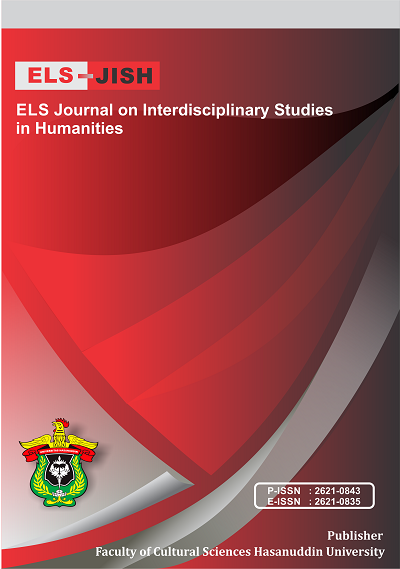A Model of Wolio Language Maintenance Strategies in Society 5.0
DOI:
https://doi.org/10.34050/elsjish.v5i2.21510Keywords:
Language Maintenance, Mother Tongue, Strategy Model, Wolio LanguageAbstract
This study aims to describe the Wolio language maintenance strategy model in the 5.0 era of society. This study uses qualitative research methods within the scope of sociolinguistic studies. Data were collected through library studies, and field studies. The results of this study describe five models of strategies for maintaining the Wolio language as a mother tongue, namely: 1) strengthening the preservation of Wolio customs and culture, 2) strengthening the role of Wolio traditional and cultural institutions, 3) strengthening the role of government, 4) strengthening the role of the family, and 5) strengthening the use of the latest communication and social media. The results of this study indicate that language maintenance in era 5.0 still requires the involvement of various elements, the government, the community, parents, and traditional leaders. In addition, language maintenance must be carried out by maintaining community traditions and customs because languages that lose their culture will die slowly, and traditional traditions that lose their language will lose their sacredness. The use of the latest social media is also very important in maintaining language to respond to the 4.0 revolution. If not, the language will begin to be abandoned by its speakers, especially the younger generation, because they are considered inflexible, not prestige and left behind, or old-fashioned..
References
Abas, Husen A., Kadir M., Ibnu N., & Shaidy. (1983). Struktur Bahasa Wolio. Jakarta: Pusat Pembinaan dan Pengembangan bahasa, Departemen Pendidikan dan Kebudayaan.
Anceaux, J.C. (1987). Wolio Dictionary (Wolio-English-Indonesian). Dordrecht-Holland: Foris Publications Holland.
Badan Bahasa. (2019). Wolio. https://dapobas.kemdikbud.go.id/home?show=isidata&id=287.
Chaer, A. (2010). Sosiolinguistik: perkenalan Awal. Jakarta: Rineka Cipta.
Crystal, D. (2003). Languange death. New York: Cambridge University Press.
Grenoble, L.A. & Whiley, L.J. (2006). Saving Languange: An ntruduction to Languange revitalization. New York; Cambridge University Press.
Halim, Amran. (Ed.). (1984). Politik Bahasa nasional. Jilid II. Jakarta: Balai Pustaka.
Kridalaksana, H. (2008). Kamus Linguistik. Jakarta: PT Gramedia Pustaka Utama.
Mbete, A.M. (2010). Strategi Pemertahanan Bahasa-bahasa Nusantara. Dalam Seminar Nasional Pemertahanan Bahasa Nusantara. http://eprints.undip.ac.id/36865/1/1.pdf
Kamaluddin, dkk. (2016). Bahasa Wolio Riwayatmu, Kendari: Universitas Haluoelo Press.
Kamaluddin, dkk. (2020). Penyusunan naskah Akademik Rancangan Perda Pelestarian Bahasa, Aksara dan Sastra Wolio. Baubau; Belum dipublikasikan.
Kudus, I. A. Munafi, & Mansyur, F.A., (2020). Ensiklopedi Atraksi Budaya dan Religi Buton. Baubau: Dinas pariwisata Kota Baubau.
Mansyur, F. A. (2013). Sistem Sapaan Bahasa Wolio”. Tesis. Yogyakarta: Pascasarjana FIB UGM.
Mansyur, F.A. (2016). Onina Manga Mancuana Mangenge: Cultural Value of Wolio People that never Fade (A Study of Anthropological Linguistics). Proceedings of Prassati. Retrieved from 1 / pras.v0i0.1526.
Mansyur, F.A. (2018). Onina Manga Mancuana Mangenge: Traditional Wolio (Doctoral dissertation). Retrieved from.http://digilib.fib.ugm.ac.id/digital/filter/960.
Mansyur, F. A. (2020a). A Cognitive Semantics Analysis of Wolio Proverbs Related to the Human Body. Advances in Social Science, Education and Humanities Research, volume 436, Published by Atlantis Press SARL. Retrieved from https://www.atlantis-press.com/proceedings/bis-hess-19/articles.
Mansyur, F. A., & Suherman, L. A. (2020b). The Function of Proverbs as Educational Media: Anthropological Linguistics on Wolio Proverbs. ELS Journal on Interdisciplinary Studies in Humanities, 3(2), 271-286. https://doi.org/10.34050/els-jish.v3i2.10505.
Mansyur, F. A., Nuryadin, C., Muchtar, M., Sahril, S., & Amayliya, W. O. A. (2021). Character Education Values in Indonesian Proverbs. ELS Journal on Interdisciplinary Studies in Humanities, 4(3), 346-354. https://doi.org/10.34050/elsjish.v4i3.18017.
Munafi, L. O. A.. (2011). Sistem Kekerabatan dalam Kebudayaan Wolio. M. Mu’min Fahimuddin (Ed.). Menafsir Ulang Sejarah & Budaya Buton. Baubau: Respect.
Nurhayati, E. Mulyana, H. Mulyani, & Suwardi. (2013). Startegi Pemertahanan Bahasa Jawa di Provinsi Daerah Istimewa Yogyakarta. Litera, 12 (1): 159-166. DOI: https://doi.org/10.21831/ltr.v12i01.1338.
Nusantara, T. (2020). Society 5.0 Dan Riset Perguruan Tinggi Indonesia. Prosiding Seminar Nasional Berseri, 1(1), 1-20. https://doi.org/10.22236/semnas/111-20166
Pusat Bahasa. (2005). Bahasa-Bahasa di Indonesia. Dendy Sugono, Mahsun, Inyo Yos Fernandez, Kisyani Laksono, Multamia Lauder, dan Nadra (Ed.). Jakarta: Pusat Bahasa, Departemen Pendidikan Nasional.
Sailan, Z.(2014). Pemertahan Bahasa Muna di Kabupaten Muna Sulawesi Tenggara. Litera, 13 (1): 191-200. DOI: https://doi.org/10.21831/ltr.v13i1.1915.
Salam, S. Ponto, D.(2021). Pemertahanan Bahasa Minahasa di Desa Kaaruyan. Ideas: Jurnal Pendidikan, Sosial, dan Budaya, 7 (3): 241-252. Doi: https://doi.org/10.32884/ideas.v7i3.402.
Laxmi, L., Shri Ahimsa Putra, H., Setiadi, S., Alamsyah Mansyur, F., Ode Abdul Munafi, L., & Udu, S. (2022). Sara Kidina in Buton: The Perspective of History, Culture and Quality of Life. KnE Social Sciences, 7(8), 508-521. https://doi.org/10.18502/kss.v7i8.1077.
SIL. (2006). Bahasa-Bahasa di Indonesia. Jakarta: SIL International.
SIL. (2016). Ethnoloque: Languages of The World. Retrieved from https://www.ethnologue.com.language/wlo.
SIL. (2022). Languange Vitality. Retrieved from https://www.sil.org/language-assessment/language-vitality#:~:text=Language%20vitality%20is%20demonstrated%20by,daily%20use%20in%20the%20home.
Spradley, J.P. (1997). Metode Etnografi. Yogyakarta: Tiara Wacana.
Sudaryanto. (1990). Menguak Fungsi Hakiki Bahasa. Yogyakarta: Duta Wacana University Press.
Umbu, L. (2011). Wangi Ramadhan di Negeri Butun. Dalam M.M. Fahimuddin (Ed.). Menafsir Ulang Sejarah & Budaya Buton. Baubau: Respect.
UNESCO.(2003). Languange Vitality and Endeargemen. America: International Expet Meeting on UNESCO.
Wahidin, L.M. B. (2011). Tradisi Pingitan (Posuo) dalam Masyarakat Buton. Dalam M.M. Fahimuddin (Ed.). Menafsir Ulang Sejarah & Budaya Buton. Baubau: Respect.
Wati, F. & Sahlan. (2017). Pemertahanan Bahasa Wolio Sebagai Warisan Budaya Buton. Jurnal Bastra 1 (4):1-6.
Zahari, A. M. (1977). Sejarah dan Adat Fiy Darul Butuni. Jilid 1. Jakarta: Departemen Pendidikan dan Kebudayaan.
Downloads
Published
Issue
Section
License
Copyright (c) 2022 Firman Alamsyah Mansyur, Arsad, Asrul Nazar, Isti’anatul Hikmah, Zilani

This work is licensed under a Creative Commons Attribution-NonCommercial-ShareAlike 4.0 International License.






